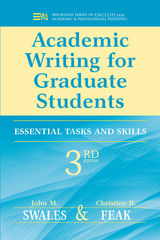
Among the many changes in the third edition:
*newer, longer, and more authentic texts and examples
*greater discipline variety in texts (added texts from hard sciences and engineering)
*more in-depth treatment of research articles
*greater emphasis on vocabulary issues
*revised flow-of-ideas section
*additional tasks that require students to do their own research
*more corpus-informed content
*binding that allows the book to lay flat when open.
The Commentary (teacher's notes and key) (978-0-472-03506-9) has been revised expanded.
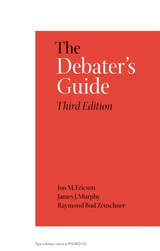
Thousands of debaters at all levels have relied on this practical guide for reference and instruction in argumentation and communication since it was first published in 1961. Now in a third, fully revised edition featuring restructured chapters, updated examples, and the addition of parliamentary debate as a form, The Debater’s Guide continues to be the leading handbook for helping both novice and advanced students develop the skills necessary to successfully apply the basic principles of debate.
Cutting through theory with clear explanations and specific applications, this compact volume with a broad scope offers students and teachers no-frills assistance in resolving the major problem faced by debaters: the need to present arguments forcefully and cogently while reacting effectively to criticism. Readers are advised on matters from budgeting time in a debate to speaking in outline form through a well-organized series of explanations, specific examples, and graphic presentations related to both policy and value issues.
Beginning with a clear explication of basic principles, The Debater’s Guide presents chronologically the steps of building a debate case, reviews the strategy of planning for refutation and defense, and offers sound advice on presenting the case in oral discourse. Expanded contents pages and effective use of subheadings allow for quick reference to any particular aspect of debate, making it an excellent classroom text as well as a valuable, hands-on tool during actual debates. A glossary of key terms used in debate complements the volume.

The increase in our knowledge of the solar system during the five years since the author last revised this book (1963) greatly exceeds that in the previous two decades. The program of the U.S. National Aeronautics and Space Administration and the space program of the U.S.S.R. have been prime contributors to this rapid progress, but the impetus has carried over to groundbased studies of the Moon and planets as well. The advances in radio and radar astronomy alone are striking, and are continuing at an accelerating pace.
This third edition of Mr. Whipple's popular and authoritative book is thoroughly revised in light of this new knowledge. The most extensive revisions are in the chapters on the Moon, Mars, and Venus--the members of the solar system on which the various space programs have concentrated. The author has included many new and dramatic illustrations in this third edition, among them photographs taken from U.S. and Russian space craft. There are striking photographs of the Moon, with close-up views of its surface texture, pictures of Mars taken from Mariner IV, and radar pictures of Venus that "see through" that planet's obscuring cloud layer.
The book is written in nontechnical language and with a lucid, witty style that is readily understandable to the interested layman. Mathematics has been avoided, and scientific methods and processes are described in simple terms. In presenting the latest information about the planets and their moons, Mr. Whipple discusses their origin and evolution, motions, atmospheres, temperatures, surface conditions, the environment essential for life as we know it, and the possibilities of life outside the Earth. He concludes with a discussion of current theories about the origin of the solar system.
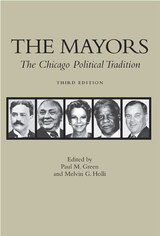
The Mayors: The Chicago Political Tradition taps America’s most qualified observers to scrupulously assess the city’s mayors within the vigorous and tumultuous history of Chicago government. This revised and updated edition features extensive commentary on the enduring mayoral influence of Richard M. Daley.
“In the seventeen years since The Mayors was first published,” editors Paul M. Green and Melvin G. Holli write in the Preface to this edition, “Chicago politics has become more genteel, more docile, and more predictable. This dampening of the city’s once red-hot political coals is due to domination by one man: Mayor Richard M. Daley.” Also providing a political roadmap through the complex and fascinating labyrinth of Chicago politics are essays on other recent mayors: Richard J. Daley, Michael A. Bilandic, Jane M. Byrne, and Harold Washington.
Green and Holli’s popular study maintains that the key to the mayor’s office is power: the power to reward and the power to punish that comes with occupying the fifth floor of city hall in Chicago. Beginning with Joseph Medill, the Tribune publisher who guided the city in its rise from the ashes after the Great Fire of 1871, The Mayors takes readers through the terms of some of the city’s most colorful leaders: from the progressive Carter Harrison II and the radical Edward F. Dunne to the politically reticent Fred A. Busse and the loudmouth Big Bill Thompson. The essays collectively tell a riveting story of structures wherein aggressive power brokers surmount even massive corruption and scandal, and those who fail to seize the office’s inherent authority have short, uncomfortable tenures.
In addition to Green and Holli, contributors include David L. Protess, Edward R. Kantowicz, John D. Buenker, Maureen A. Flanagan, Douglas Bukowski, John R. Schmidt, Roger Biles, Arnold R. Hirsch, William J. Grimshaw, Monroe Anderson, Steve Neal, Steve Rhodes, and Laura S. Washington.
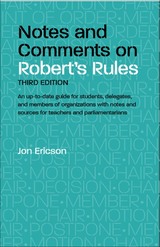
This third edition of Jon Ericson’s Notes and Comments on Robert’s Rules updates all references and page numbers to the tenth edition of Robert’s Rules of Order Newly Revised, published in 2000. Ericson’s guide to the authoritative parliamentary resource clarifies many of the concepts and rules that intimidate or confuse the members of organizations who use it, stressing that they have a choice in—and may, in fact, modify—the rules by which they are bound.
Ericson begins with the Order of Precedence, which he defines as the key concept in understanding and utilizing parliamentary procedure. He then uses a question-and-answer format in which a logical progression of essential parliamentary questions is explicitly answered, with a rationale for each rule. Throughout, he provides specific page references to Robert’s Rules. Through these three elements, he makes classic doctrine intelligible and workable, leading the reader step-by-step through the rules and their applications and, in the process, encouraging people to feel more positive about parliamentary procedure and their ability to use it.
“Far too many members, armed—or more accurately disarmed—with a misconception of parliamentary procedure, choose to spend a lifetime wondering what is going on and lamenting or blaming others when things fail to go their way,” writes Ericson in the Introduction. “Understanding parliamentary procedure also allows a person to have more fun—not just the fun of socializing outside the business meeting—but the fun of performing in the public arena.”
A popular, concise, and clear handbook, Notes and Comments on Robert’s Rules emphasizes the simple machinery of the system, relates its concepts to the procedures most commonly used in meetings and conventions, and encourages members to obtain and study, rather than shy away from Robert’s Rules of Order Newly Revised. This new edition also expands the number of question-and-answer sections and surveys the research in and commentary on the field since 1991. A laminated, removable card featuring simplified charts of parliamentary motions serves as an additional resource and is included with the volume.

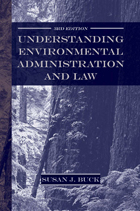
Understanding Environmental Administration and Law provides an engaging, introductory overview of environmental policy. Author Susan J. Buck explores the process through which policy is made, the political environment in which it is applied, and the statutory and case laws that are critical to working within the regulatory system. This revised and expanded third edition adds case studies that help bring the subject to life and includes new material on:
- the Bush Administration and its approach to administering environmental laws
- the continuing evolution of environmentalism and the changing role of environmental regulation in the United States
- the development and implementation of environmental agreements at the international level
- the impacts and implications of globalization
Understanding Environmental Administration and Law provides a framework for understanding the law as a managerial tool.
READERS
Browse our collection.
PUBLISHERS
See BiblioVault's publisher services.
STUDENT SERVICES
Files for college accessibility offices.
UChicago Accessibility Resources
home | accessibility | search | about | contact us
BiblioVault ® 2001 - 2024
The University of Chicago Press









